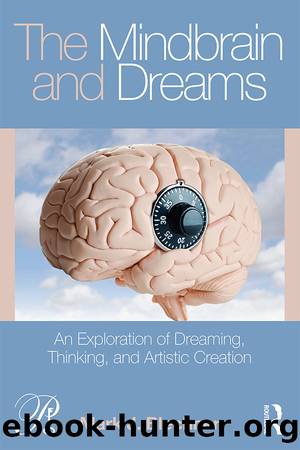The Mindbrain and Dreams by Mark J. Blechner

Author:Mark J. Blechner
Language: eng
Format: epub
ISBN: 9781351185653
Publisher: Taylor & Francis (CAM)
Published: 2018-03-12T00:00:00+00:00
A note on Bion
Wilfred Bion (1962/1977) proposed that waking thinking involves the transformation of raw sensory data, which he called beta elements, into symbolized thoughts, which he called alpha elements. His theory raises significant questions, parallel to those I am exploring in this book, about the substrate of thought and the place of dreaming in relation to the substrates of thought. Bion referred to alpha function as an âas yet unknown set of mental operations that, together, transform raw sense impressions (beta elements) into elements of experience (alpha elements)â (1962, p. 17) His idea, much debated, seems to me to be a transformation by the mindbrain of sense impressions into more abstract and symbolized material, which becomes what I call âthe substrate of thought.â
The mental transformations that I have outlined in the first part of this book may comprise some of the operations Bion was expecting to find. However, many of the transformations I have described are not transformations of raw sensory data, but transformations of one set of mental representations (which I would consider alpha elements) into another set of alpha elements.
Whereas Bion talks of psychosis as a failure of symbolization, I and others have noted that in psychosis, the symptoms (including hallucination and delusions) contain symbolization of psychological conflicts.30 And when the symptoms abate, the symbolization of their symptoms can be incorporated into their dreams (Arieti, 1963; Blechner, 1983; Marcus, 1992; Quinodoz, 1999).
Ogden (2003) has reconsidered Bionâs ideas and proposed that some people, even though they report having dreams, may be incapable of what he calls âtrue dreaming,â where âtrue dreamingâ involves alpha elements. Ogdenâs proposal has led to some chaos, where a clinician who cannot make sense of a patientâs dream may take flight in the notion that the dream is not a true dream (e.g., Sands, 2010; Blechner, 2010).
Ogden gives as an example the Borges story âFunes the memoriousâ (1941/1962) in which a man remembers every detail and is incapable of normal forgetting. In my opinion, Funes is an example of a mnemonist, an individual with an extraordinary memory for detail. Mnemonists highlight the importance in human thinking of forgetting to allow concept formation, illustrated most vividly in nonfiction by Luria (1987) in The Mind of the Mnemonist. It would be useful to find out how savants experience falling asleep, what their dreams are like if they can dream at all, and how they remember them (Blechner, 2003).
It would also be useful to discover how savant syndrome is related to a biological operation in sleep known as âsynaptic scaling,â a process of altering the structure and molecular machinery of synapses (Acsády and Harris, 2017; de Vivo et al., 2017; Diering et al., 2017). Studies suggest that this neurological shrinkage of dendritic spines might be connected with computational processes such as memory consolidation and informational transformation during sleep. Much of our thinking involves selective forgetting and filtering, so that the gist and essence may be seen more clearly. Perhaps in the future it will be possible to
Download
This site does not store any files on its server. We only index and link to content provided by other sites. Please contact the content providers to delete copyright contents if any and email us, we'll remove relevant links or contents immediately.
Spare by Prince Harry The Duke of Sussex(5133)
Machine Learning at Scale with H2O by Gregory Keys | David Whiting(4257)
Fairy Tale by Stephen King(3305)
Will by Will Smith(2872)
Hooked: A Dark, Contemporary Romance (Never After Series) by Emily McIntire(2527)
The Bullet Journal Method by Ryder Carroll(2524)
Rationality by Steven Pinker(2326)
Can't Hurt Me: Master Your Mind and Defy the Odds - Clean Edition by David Goggins(2267)
It Starts With Us (It Ends with Us #2) by Colleen Hoover(2252)
Friends, Lovers, and the Big Terrible Thing by Matthew Perry(2178)
The Becoming by Nora Roberts(2148)
Love on the Brain by Ali Hazelwood(2020)
HBR's 10 Must Reads 2022 by Harvard Business Review(1820)
The Strength In Our Scars by Bianca Sparacino(1817)
A Short History of War by Jeremy Black(1815)
Leviathan Falls (The Expanse Book 9) by James S. A. Corey(1695)
A Game of Thrones (The Illustrated Edition) by George R. R. Martin(1657)
515945210 by Unknown(1640)
Bewilderment by Richard Powers(1575)
